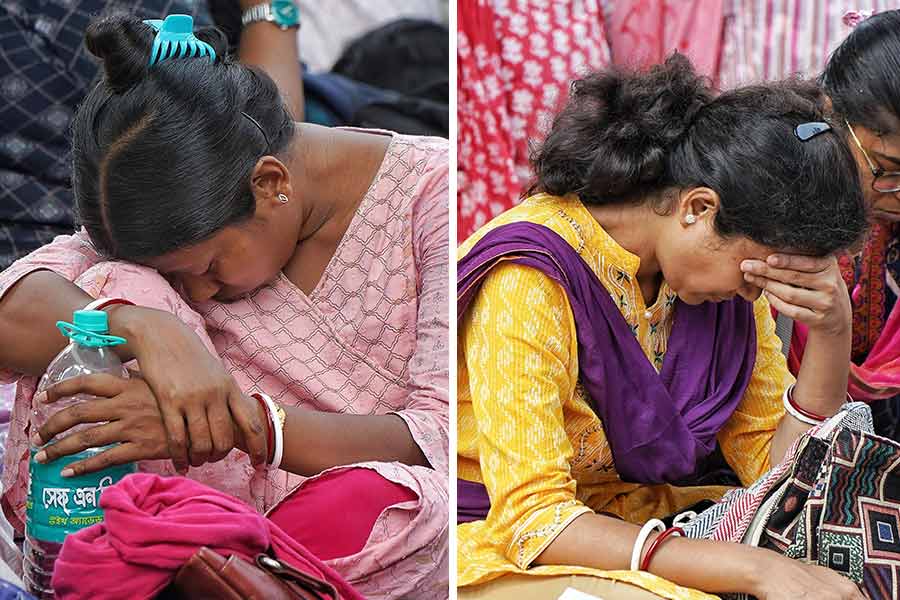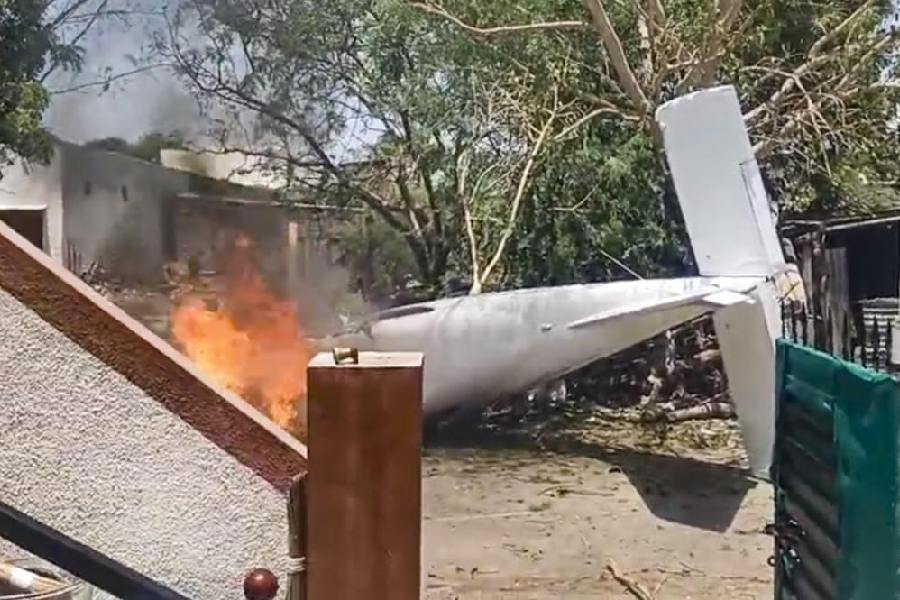 |
 |
| The bungalow amid the Belghoria Calcutta Police Housing Estate; (below) the rear side of the building. Pictures by Anindya Shankar Ray |
The Belghoria Calcutta Police Housing Estate is a conglomeration of stunted, malformed boxes nestled amidst the beauty of nature. The driveway that leads to it is close to Dunlop bridge and off BT Road.
This driveway is like any other driveway, except that it is lined with lofty deodar and krishnachura trees. It leads to a vast open area covered with greenery, standing amidst which are the dreary houses. Large tanks covered with algae stretch from one end of the housing estate to its extremity. This tank has a ghat — a flight of stairs leading down to the water, close to RN Tagore Road on the south. At this end it is heavily shaded with trees. The lush beauty of nature overwhelms the ghastliness of the concrete cages.
Standing in the middle of a jungle of weeds is a single-storeyed bungalow in a shambles. Above the staircase is a row of five columns with capitals of the Ionic order upholding a pediment.
The columns are connected by a screen of wooden slats. Behind the building is a porch with columns, louvred and falling to pieces. It resembles a giant ribcage. The plinth has arches and inside the cavity saris hang on a line.
The building may be in dire straits but it has nurtured a jungle of parasites that shoot out of it like hair standing on end or human beings throwing up their hands in despair. People play cards on the porch, braving the mosquitoes buzzing around in large squadrons that mercilessly attack human beings.
I had heard of this abandoned house from a former colleague, and true to her description, it is a fascinating pile with a romantic aura that holds a secret close to its chest. It did take me a couple of months to unravel its story which was not even remotely romantic.
When I was giving up in despair unable to identify its past owner, I sighted a wiry old gentleman. He said he was Haripada Das, who was formerly with the police. After retirement he settled down in Tagore Park on RN Tagore Road. He said the entire tract once belonged to A.K. Sarkar. But beyond that he knew little. Even P.K. Sanyal, the joint commissioner of police (organisation), whose office is in Lalbazar, could not enlighten me.
But some police officers of that area introduced me to Kamalesh Banerjee, in his 70s, who told me the story of A.K. Sarkar and how he lost his estate. Banerjee is a retired special duty officer of the cottage and small scale industries department of the West Bengal government. A.K. Sarkar, he said, was a hurricane lantern manufacturer whose factory was located on the spot where the police quarters were built later.
Sarkar had taken a loan from the state government but in the late 1950s he had defaulted on payment of his instalment. The loan the industrialist had taken would not be enough to buy even a cottah today, says Banerjee. Bidhan Chandra Roy was chief minister then, and he was cottage industries minister as well. A.K. Sarkar’s property covering three-and-a-half to four acres was confiscated under the Bengal State Aid to Industries Act.
The land became the property of the cottage and small scale industries department, of which the police were apportioned the lion’s share as it was badly in need of housing. The health department set up a factory for manufacturing X-ray machines. The cottage and small scale industries department set up two units — the Belghoria unit of the Ceramic Development Corporation and the Electronic Test & Development Centre, both defunct now.
Banerjee could not say what purpose the bungalow served. But it is said it served as the barracks of policemen who kept vigil in that area. Subsequently, an IPS officer had lived there for some time. Later it was abandoned and now it is a lair of snakes.
Calcutta historian Debasish Basu added a few biographical details about A.K. Sarkar. His first name was Abani Kanta, and he was youngest of three brothers — Nishi Kanta, who became insolvent, and Jamini Kanta. They were from Burdwan but in the 1930s they had settled down in Howrah. Ujala was the brand name of the hurricane lantern that Abani Kanta manufactured. They were enormously rich and their heyday was in the 1940s-1950s. Ujala’s city office was in Dalhousie Square opposite Telephone Bhavan. Now there is no trace of that either.











